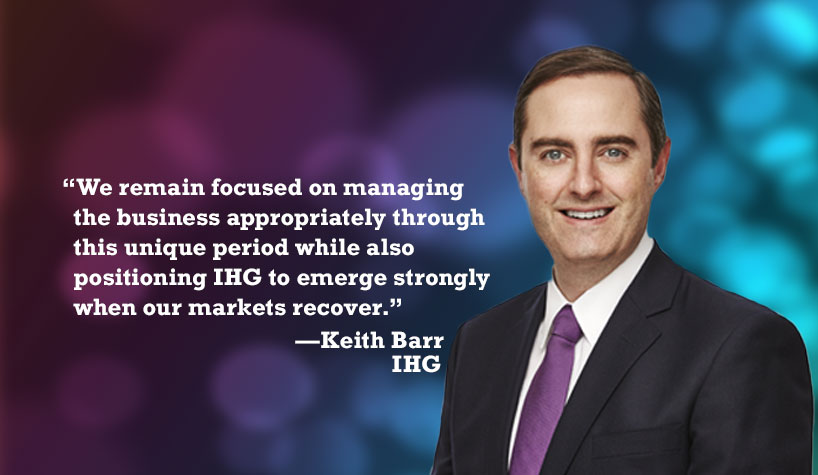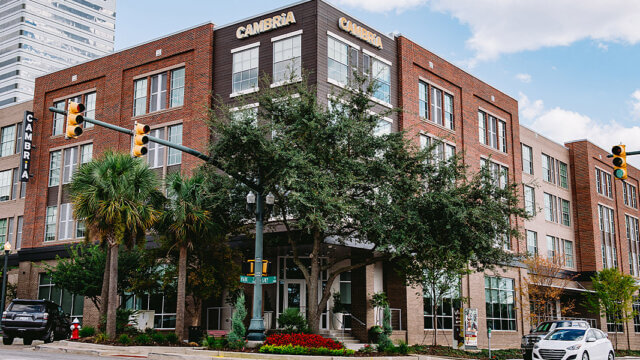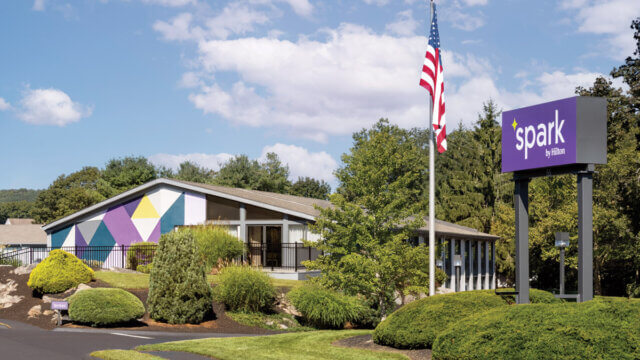LONDON—For the first quarter of 2020, IHG’s group comparable RevPAR was down 25.9%—including a drop of 55% in March—with an expected April decrease of around 80%. About 1,000 (15%) of the group’s hotels were closed at the end of April, including around 440 in the Americas.
“COVID-19 represents the most significant challenge both IHG and our industry have ever faced. We are responding on every front and taking decisive action to the benefit of all our stakeholders,” said Keith Barr, CEO of IHG. “Our top priority remains to support our guests, colleagues and hotel owners through this crisis, while protecting for the long term and positioning the business for recovery.”
Other Q1 highlights include the following:
- Occupancy levels in comparable open hotels were in the low-to-mid 20% range
- 4.6% year-over-year (YOY) net system size growth to 882,000 rooms
- 6,000 rooms opened, including 1,000 in March
- 14,000 rooms were signed (104 hotels), including 4,000 in March, taking the pipeline to 288,000 rooms
- Delivering on the company’s cost reduction and cash conservation actions across the System Fund and Fee Business; on track to reduce Fee Business costs by up to $150 million and CapEx by about $100 million; further cost measures to be implemented to manage the business through the evolving trading environment
- About $2 billion of liquidity available; extension secured on $1.3 billion syndicated revolving credit facility until September 2023 in addition to covenant waivers already in place; 600 million pounds (about $740 million) of COVID Corporate Financing Facility (CCFF) funding issued
“Following a solid performance in the first two months of 2020, occupancy levels dropped to historic lows in March and April, as social distancing measures and travel restrictions came into effect around the world,” said Barr. “In the U.S., our biggest market, our franchise portfolio of 3,750 mainstream hotels has seen lower levels of RevPAR decline than the industry, and at the end of April, we had about 90% of our estate open. Our business is also weighted toward non-urban markets that are less reliant on international inbound travel and large group meetings and events, which provides a level of resilience during this difficult period.”
He continued, “Building on our conservative balance sheet approach, we are delivering on our plans to reduce costs, preserve cash and strengthen our liquidity. We remain focused on managing the business appropriately through this unique period while also positioning IHG to emerge strongly when our markets recover. We anticipate continued disruption to travel in the months ahead, and forward visibility on the timing and shape of improvements in demand remains very limited.”
Americas
RevPAR was down 19.3% in Q1, driven by occupancy declines of 10 percentage points. In the U.S., RevPAR was down 19.6% for the quarter and 49% in March, impacted by the sharp decline in travel due to the outbreak of COVID-19. March performance was ahead of both the industry and the company’s weighted segments, with relative outperformance across mainstream and extended-stay brands.
Elsewhere in the region, Canada was down 20% in Q1, Latin America and the Caribbean were down 14% and Mexico was down 18% (with declines in March of 51%, 49% and 45%, respectively).
At the end of April, about 90% of IHG hotels across the Americas were open, with the luxury and upscale portfolio seeing the greatest impact. The company expects occupancy levels for comparable open hotels in the mid-20% range. IHG opened 2,500 rooms (26 hotels) and removed 3,500 rooms (27 hotels) in the quarter, with net system size growth of 2.4% YOY. Construction activity continued through April, albeit at lower levels, with 10 hotels breaking ground during the month. IHG signed 6,100 rooms (61 hotels) in the quarter, including 12 Avid hotels and five Atwell Suites.
“The upper-midscale segment has proved to be more resilient, as it was through previous downturns. Through the financial crisis of 2008-09, upper-midscale RevPAR fell around 15%, compared to luxury and upper-upscale, which fell between 18% and 25%,” said Paul Edgecliffe-Johnson, CFO/group head of strategy. “We are seeing a similar trend in March, when upper-midscale RevPAR outperformed both of these segments combined by around 16 percentage points. We also have the strongest brands in this segment, with Holiday Inn Express outperforming the upper-midscale by nearly three percentage points in March.”
He continued, “Around 85% of our rooms are in non-urban markets, which also tend to hold up better in tough economic conditions. RevPAR in our non-urban markets declined 45% in March against an over 60% decline in urban markets. In addition, our hotels are less reliant on international inbound travel, with around 95% of our demand being domestically driven. We are also less exposed to large meetings and events, which tend to be the first to fall away, and the last to recover in a recession environment.”
Europe, Middle East, Asia & Africa
RevPAR was down 25.7% in Q1, including a 63% decline in March. Q1 RevPAR was down 22% in the U.K. (March down 55%), with London down 25% (March down 61%). Continental Europe RevPAR was down 28% for the quarter (March down 72%). Elsewhere, the Middle East was down 21% for the quarter (March down 60%), while Australia and Japan were down 22% and 35% respectively.
At the end of April, there were about 560 hotels closed across EMEAA, reflecting the timing of mandated lockdowns by governments in the region. Occupancy levels for comparable open hotels are running in the low-20% range on average, and RevPAR for April is expected to be down around 90%. IHG opened 1,500 rooms (10 hotels), driving net rooms growth of 3.5% YOY. Removals of 3,600 rooms included 2,100 relating to a previously flagged portfolio of hotels in Germany. The company signed 2,500 rooms (12 hotels) in the quarter, including two hotels for Six Senses and the first Kimpton property in Malaysia, and subsequent signings include an InterContinental in Rome.
Greater China
First quarter RevPAR in Greater China was down 65.3%, reflecting the outbreak of COVID-19 in January. RevPAR was down 89% in February, improving modestly to an 81% decline in March and to an expected decline of about 75% in April. In Mainland China, Q1 RevPAR declined 63%. RevPAR in Tier 1 and 2 cities declined 64%, and Tier 3 and 4 cities fell 59%.
There were 10 hotels closed across Greater China at the end of April, compared to 178 closed at the peak of the outbreak. Recent weeks have continued to see a moderate improvement in occupancy levels, which are running in the mid-20% range, up from about 5% in mid-February. IHG opened 2,000 rooms (eight hotels) in the quarter, with net rooms growth of 16.2% YOY. Construction work has resumed on about 95% of hotels that are due to open this year. Signings totaled 5,600 rooms (31 hotels), including 22 franchise signings across the Holiday Inn Express, Holiday Inn and Crowne Plaza brands.
Barr noted that his company is in a good position to recover once travel resumes on a somewhat normal basis.
“It is important to underline the strength of our business model to withstand this pressure,” he said. “First, we are an asset-light business with most of our revenue tied to hotel revenues, not profits. Second, we skewed toward transient demand as opposed to large group bookings, which are more impacted by social distancing measures and reduced travel budgets. Third, our broad geographical distribution is weighted toward domestic demand, mostly in non-urban markets, both of which are expected to lead the recovery as international travel restrictions persist. And finally, [we have] a market-leading position within the upper-midscale segment, which has historically outperformed during downturns.”



